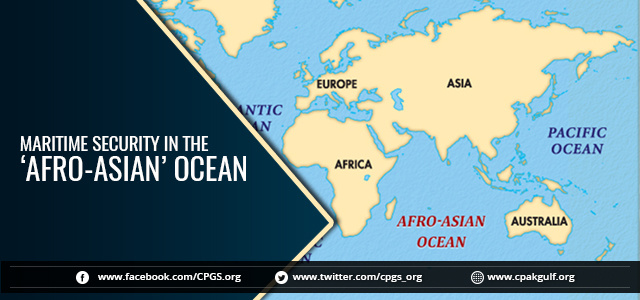By Senator Sehar Kamran (TI)
May 01 2017
 “Control of the sea by maritime commerce and naval supremacy means predominant influence in the world … (and) is the chief among the merely material elements in the power and prosperity of nations.”
“Control of the sea by maritime commerce and naval supremacy means predominant influence in the world … (and) is the chief among the merely material elements in the power and prosperity of nations.”
–Alfred Thayer Mahan
The seas have always been gateways to the prosperity and survival of States, facilitating the vast majority of global trade and communications; consequently, maritime security has been of vital importance for the national interests of states. The Afro-Asian Ocean is particularly important, forming the pathway for approximately 70 percent of all global trade and more than 80% of the world’s seaborne oil trade. The term Afro-Asian Ocean may be a surprising new term for many, but it is by no means a novel idea – it has been suggested previously on numerous occasions, and seems the most pertinent to me. It is only through an odd twist of circumstance, however, and in complete contradiction of both geographic and geopolitical realities, that the ‘Indian’ Ocean became the only one in the world to be named after any one country – India. The name is undoubtedly a misnomer, particularly for waters that touch such a vast array of nations and two continents. The Ocean extends from Durban to Perth, touching the entire eastern coastline as well as parts of northern and southern Africa, the western shores of Iran, Pakistan, Sri Lanka, Thailand, Indonesia and numerous island states, and this is a problem, as the misnomer is preventing its 32 bordering nations from taking charge of their destinies in the region, while allowing one State to treat the entire area as its personal backyard. In this context, the name `Afro-Asian Ocean` would be far more pertinent, and this is the nomenclature that I will be employing in this article.
In order to establish the dimensions and paradigm for maritime security in the Afro-Asian Ocean, it is important to first establish the context for its necessity. As indicated previously, the Ocean holds crucial geostrategic significance, as it houses limitless resources, in addition to numerous trade routes, ports and choke points, including three of the world’s most important choke points – the Straits of Hormuz, Bab-al-Mandeb and Malacca. More than 100,000 ships transit through this ocean annually. It is the world’s third largest ocean covering an area of approximately 68.5 million square kilometers, houses about a third of the global population, connects one fourth of all landmass, in addition to housing three-fourths of the global reserves of oil, iron and tin. The world’s most important Sea Lines of Communication (SLOCs) pass through the Afro-Asian Ocean.
Recently, we have been witnessing a reprioritisation of maritime borders and trade routes in this region, and a resurgence of competition for influence and control in international waters. The Afro-Asian Ocean has reemerged as a focal point in international geostrategic discussions. As the potential of this region remains largely untapped, ensuring the protection of resources which lie beneath those waters is increasingly becoming as significant as defending a country’s land-based borders.
A large proportion of all conflicts since the Second World War have occurred in or around the Afro-Asian Ocean Region. History seems to be repeating itself again as even today, the AAOR remains one of the most militarised regions in the entire world, housing large contingents of international troops, including the French, British, and the US – which alone has over 360,000 troops. While such massive deployments are mostly either of coalition forces or of navies in collaborative and/or coordinated deployments, competition for control and security of important choke points nonetheless creates space for power rivalry, especially on the basis of clashing geo-strategic and geo-economic interests.
Furthermore, the nuclearisation of the Afro-Asian Ocean is raising the stakes for strategic stability, both of the littoral states, and the extra-regional stakeholders. India’s plans for a blue water navy, its introduction of ballistic missile submarines (SSBNs) and nuclear-powered general-purpose attack submarines (SSNs) in an arena that does not yet have very strong dispute resolutions mechanisms, not only heightens the possibility for nuclear escalation, but also creates new space for hegemonic coercion by a self-appointed ‘net safety provider’, and it is the disproportionate support and encouragement of one major power – the US – towards these developments that is threating to disrupt regional stability by promoting hegemonic designs in the AAOR.
Historically in Pakistan, unfortunately, there has been a distinct tendency to neglect this arena, with traditional strategic imperatives focused almost entirely landwards, despite the fact that the maritime sector is the bedrock of our national economy. However, with Pakistan’s recently expanded continental shelf, and developments like the operationalisation of CPEC and Gwadar, the seas have regained the attention of strategic and policy-making circles. Under CPEC, Pakistan is seeking to become the connector between the land and sea routes of One Belt One Road (OBOR), and in conjunction with the launch of Gwadar Port, these developments further consolidate Pakistan’s geo-strategic importance. Within the maritime arena, this translates to a multitude of regional and trans-regional economic prospects.
However, evolving regional strategic relationships are threatening the fruition of Pakistan’s strategic imperatives. To date, despite various constraints, Pakistan Navy has proven highly effective in successfully thwarting any challenges faced by the country in this domain, upholding `time and again’ its reputation and credibility worldwide. But in order for the economic evolution on our horizon to occur, the transition must be managed with the utmost care.
Tackling any challenge requires constant vigilance, and one as sensitive as maritime security in the Afro-Asian Ocean demands even greater attention. Having recognized this challenge, it is similarly important to acknowledge that managing maritime security is an arduous endeavor. It requires cooperation between all stakeholders and states.
This century has rightly been dubbed as the ‘Asian Century’, and attaining this potential future demands the 3 Cs – Connectivity, Cooperation, and Communication. Pakistan is highly cognisant of the potential these upcoming opportunities are bringing to the table, and the challenges that come with them; it requires initiating cooperative mechanisms and encouraging partners to collaborate for mutual benefits. It also requires a strengthening of the country’s maritime sector, especially the capacity and capabilities of the Pakistan Navy, in line with the role it is expected to play in the near future.
For this purpose, a broad and inclusive ‘National Maritime Policy’ (NMP) must first be identified, acknowledging the various facets of maritime security, including trade, economy, environment and security, to facilitate the creation of targeted strategies for implementation. Secondly, in order to launch effective, coordinated strategies to implement Pakistan’s Maritime Policy goals, a ‘National Maritime Authority’ (NMA) must be created. At the moment, a coordinating and monitoring mechanism is lacking between the various ministries and departments of the government that tackle maritime issues; the NMA can fill this gap. Strengthening current legislation at the earliest and filling in gaps where necessary is vitally important, particularly in light of the launch of CPEC and Gwadar. Pakistan must also take the lead in the pursuit of the renaming of the Ocean through robust diplomatic efforts.
The need of the hour is the vision to foresee upcoming challenges, and prepare for them, in line with pre-identified national interests, if Pakistan is to actually achieve its dormant potential.
Same version of the article appeared in The Nation


